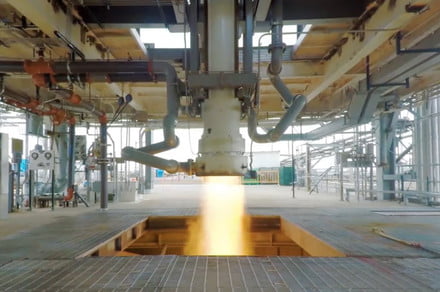[youtube https://www.youtube.com/watch?v=XEhgp2EhPao?feature=oembed&w=100&h=100]
NASA’s ambitious plan to put humans back on the moon by 2024 means there’s plenty of prep work ahead for the space agency.
An important part of that work is ensuring that the Orion spacecraft, which is set to transport the astronauts to Earth’s nearest neighbor, can handle every conceivable scenario during its challenging journey of more than 220,000 miles.
A test earlier this week at White Sands Test Facility near Las Cruces, New Mexico, saw NASA put Orion’s propulsion system through its paces for a full 12 minutes in a simulation of what the space agency described as “one of the most taxing situations the spacecraft’s engines could encounter after launch.”
Known as an “abort-to-orbit scenario,” it’s what would happen if the spacecraft failed to get on the correct path toward the moon, and requires the Orion service module’s main engine to fire in an effort to take the spacecraft into a safe, temporary orbit around Earth.
Such an orbit would give Mission Control and the astronauts enough time to evaluate the situation before deciding whether to continue with an alternate mission profile or set a course for a return to Earth.
The ground-based test involved firing Orion’s main engine on the service module, as well as all eight of its auxiliary engines simultaneously. NASA describes the service module as “the powerhouse of the Orion spacecraft,” as it provides in-space maneuvering, power, and other astronaut life support systems such as consumables like water, oxygen and nitrogen.
Commenting on the simulation, NASA’s Josh Freeh said, “This was our most demanding test for the pressurization system, including our propellant tanks, valves, and other components,” adding, “The combined international team has been working towards this test for many months.”
The noise from the blast and the shake of the camera during some of the recording (top) certainly gives you an idea of the raw power of NASA’s machinery.
Once all of the tests have been completed, the spacecraft will be transported to Kennedy Space Center for integration with the Space Launch System (SLS), the rocket that will carry the astronauts into space at the start of their mission to the moon a few years from now.
Editors’ Recommendations
-
SpaceX hopes to blast off its Starship and Super Heavy Rocket project in 2021
-
Boeing shows off Starliner test ahead of launch this summer
-
NASA thinks 3D-printing spacecraft parts in orbit will help Moon to Mars mission
-
China’s space station, Tiangong-2, has burned up in the atmosphere
-
NASA pushes ahead with Moon 2024 mission despite funding uncertainties

